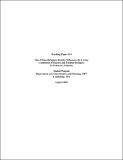How Ethno-Religious Identity Influences the Living Conditions of Hazara and Pashtun Refugees in Peshawar, Pakistan
Author(s)
Punjani, Shahid
Download14_ethno-religious.pdf (374.9Kb)
Metadata
Show full item recordAbstract
This paper examines how living conditions and settlement patterns differ between two ethnic groups belonging to the Afghan refugee population residing in Peshawar, Pakistan. Evidence from Peshawar suggests that the Pashtun, the largest and most dominant ethnic group in Afghanistan, migrate to the city largely in search of employment and/or because they no longer require humanitarian assistance. Approximately one-third of the Pashtuns interviewed had spent some time in a refugee village before settling in Peshawar. In contrast the Hazaras, among the weakest minority groups in Afghanistan, avoid refugee camps altogether. The Hazaras fear persecution in the refugee villages by other Afghans and choose to settle in cities almost immediately after entering Pakistan. Both groups, in almost equal number, cite the existence of family and friends in Peshawar as another reason for settling in Peshawar. Since refugee relief efforts are focused in refugee villages, Hazaras and other minorities living in cities tend to be excluded from aid. Relying on data collected from sixty interviews, the paper describes issues faced by both groups living in Peshawar. It concludes that organizations coordinating refugee relief efforts in Pakistan ought to consider how minority groups within the larger refugee population are affected by the concentration of humanitarian assistance in refugee villages. It argues that relief efforts sensitive to the ethno-religious identity and location of refugee can mitigate the hardships faced by those normally outside the scope of humanitarian assistance.
Date issued
2002-08Publisher
Inter-University Committee on International Migration
Series/Report no.
Rosemarie Rogers Working Paper Series;14